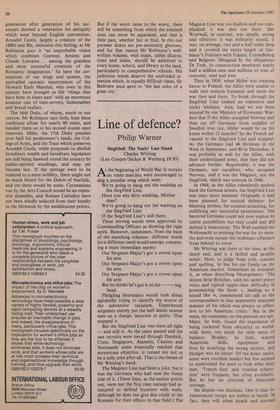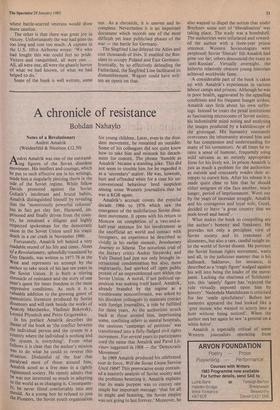Line of defence?
Philip Warner
Siegfried: The Nazis' Last Stand Charles Whiting
(Leo Cooper/Secker & Warburg £8.95)
A t the beginning of World War H recruits on route marches were encouraged to sing a popular song which went:
We're going to hang out the washing on the Siegfried Line.
Have you any dirty washing, Mother dear?
We're going to hang out the washing on the Siegfried Line If the Siegfried Line's still there.
These stirring words were approved by Commanding Officers as showing the right spirit. However, sometimes, from the back of the marching columns, different words (to a different tune) would emerge, concern- ing a more immediate enemy: Our Sergeant-Major's got a crown upon his arm Our Sergeant-Major's got a crown upon his arm Our Sergeant-Major's got a crown upon his arm But he thinks he's got it on his ing head.
Fledgling lieutenants would rush about agitatedly trying to identify the source of the subversive variation. Experienced sergeants merely put the half dozen nearest men on a charge, innocent or guilty. That stopped it.
But the Siegfried Line was there all right — and still is. As the years passed and the raw recruits were sieved through Dunkirk, Crete, Singapore, Alamein, Cassino and Normandy some eventually reached that mysterious objective. It turned out not to be a jolly joke after all. That is the theme of Mr Whiting's book.
The Maginot Line had been a joke, but it was the Germans who had seen the funny
side of it. (These lines, as the author points out, were not the first time nations had at- tempted to defend frontiers with walls, although he does not give due credit to the Romans for their efforts in that field.) The Maginot Line was too shallow and too com- plicated: it was also too short. Der Westwall, in contrast, was simple, strong and effective: it was militarily sound, it was, on average, two and a half miles deep and it covered the entire length of Ger- many's frontiers with France, Luxembourg and Belgium. Designed by the ubiquitous Dr Todt, its construction employed nearly half a million men and millions of tons of concrete, steel and iron.
Thus in 1939, when Hitler was creating havoc in Poland, the Allies were unable to walk into western Germany and settle the war then and there. To break through the Siegfried Line looked an expensive and tricky business. And, had we not been assured by our Ministry of Economic War- fare that if the Allies occupied Norway and thus cut off Germany from supplies of Swedish iron ore, Hitler would be on his knees within 12 months? So the French ad- vanced to the Siegfried Line and stopped. As the Germans had 46 .divisions in the West in September, and 80 in December, it was probably as well for the Allies, with their undertrained army, that they did not advance further. Regrettably, it was the Germans, not ourselves, who occupied Norway, and it was the Maginot, not the Siegfried, which was overrun in 1940.
In 1944, as the Allies relentlessly pushed back the German armies, the Siegfried Line was once more manned. Originally it had been planned for tactical defence: for blunting probes, for counter-attacking, for nullifying any successful penetration. The battered Germans could not now exploit its subtle possibilities but they could and did defend it tenaciously. The Wall enabled the Wehrmacht to prolong the war for six mon- ths and even mount the Ardennes offensive from behind its cover.
Mr Whiting was there at the time, at the sharp end, and is a skilled and prolific writer. Here, to judge from style, content and spelling, he has his eye firmly on the American market. Sometimes he overdoes it, as when describing Montgomery: 'The skinny little Britisher, with his rather prissy voice and typical upper-class difficulty in pronouncing the letter r, leading to a sound like w, commenced his talk to the correspondents in that apparently innocent manner of his which was always so offen- sive to his American critics.' But in the main, his comments on the generals are apt. Many, he feels, found the experience of being rocketed from obscurity to world- wide fame, too much for their sense of balance. Bradley, he feels, wasted
American skills, equipment and lives by attacking the wrong sectors, and Hodges was no better. Of the lesser ranks, some were excellent leaders but few seemed to understand the need to look after their men. 'Trench foot' and 'combat exhaus- tion' were frequent, but often avoidable. But he has no criticism of American courage.
He dispels two illusions. One is that in- experienced troops are useless in battle. In fact, they will often attack and succeed where battle-scarred veterans would show more caution.
The other is that there was great joy in victory. Unfortunately the war had gone on too long and cost too much. A captain in the U.S. 101st Airborne wrote: 'We who had fought this war could feel no pride. Victors and vanquished, all were one... All, all were one, all were the ghastly horror of what we had known, of what we had helped to do.'
Some of the book is well written, some not. As a chronicle, it is uneven and in- complete. Nevertheless it is an important document which records one of the most difficult yet least publicised phases of the war — the battle for Germany.
The Siegfried Line delayed the Allies and cost thousands of lives. It enabled the Rus- sians to occupy Poland and East Germany. Ironically, by so effectively defending the Fatherland, the Siegfried Line facilitated its dismemberment. Wagner could have writ- ten an opera on that.







































 Previous page
Previous page